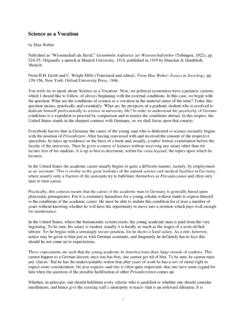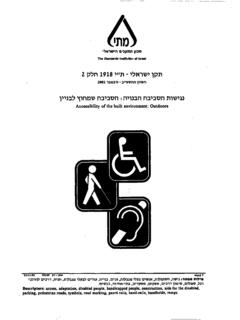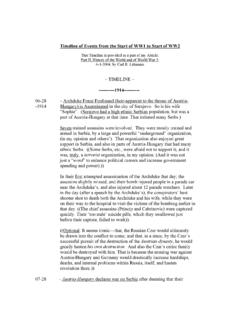Transcription of The Last Great Cavalry Charge - Moreuil Wood & …
1 The Last Great Cavalry Charge Moreuil Wood & Rifle Wood, March 1918 By Richard Laughton Lt. G. V. Laughton, The Great War situation was about to change in Europe in the early months of 1918, as Germany now had at its disposal a large number of troops that had previously been serving on the Eastern Front. As reported by Nicholson 1, the signing of the Russo-German Armistice on December 18, 1917 allowed the Germans to transfer 178 Divisions to the Western Front. During the late fall of 1917 and early winter of 1918, the Germans were preparing to launch major actions near St. Quentin, Arras, Armenti res and Ypres with 71 Divisions, 32 of which took place in the action.
2 The German offensive started on March 10, 1918 with an artillery assault on the French defences in Champagne and large scale troop movements by rail and road along the Arras-St. Quentin Line (see Nicholson Map 10 attached). General Ludendorff (Chief of Staff to Field-Marshall von Hindenburg) planned to push a hole through the British front lines, then to split the British and French forces, driving the British back to the sea. The German s had the manpower and they had the initiative, the Allies were therefore facing a major setback in their gains of the previous year. Sheffield 2 notes in his works on the war diaries and letters of British Field-Marshall Haig the following for Thursday March 21, 1918: Numerically superior in guns and men, the German forces launched Operation Michael, a massive blow against British Fifth and Third Armies.
3 Aided by dense fog, German forces made significant gains and took large numbers of prisoners, especially on the Fifth Army s front. Michael reopened mobile warfare and initiated the greatest crisis Haig had faced since October-November 1914. Haig s plan called for General Foch (French Commander) or some other determined general who would fight , to be given supreme control of the operations in France. Field-Marshall Haig wanted the French to support the British with at least 20 Divisions north of the Somme at Amiens. On March 25, 1918 Haig placed the British Fifth Army, south of the Somme, under French command. During the same period, reference to the work of Humphries 3 reports on the situation at the Canadian GHQ.
4 Canadian Lieutenant General Sir Arthur Currie was on leave in England when Operation Michael started on March 21, 1918. With Great haste Currie was back in France the following day, after crossing the English Channel by torpedo boat destroyer. Currie reported that the 2nd Canadian Division was in reserve and then on March 23, 1918 the 2nd Division was ordered to rendezvous near Arras, with the 1st Division now in reserve and the 3rd and 4th Divisions on the line. On March 27, 1918 General Curried penned a special order in which he reported the enemy has gathered all his forces and struck a mighty blow at the British Army . Currie reported that our Motor Machine Gun Brigade has already played a most gallant part and once again covered itself with glory.
5 In concluding his special report Currie made one of his most famous calls of his career: Under the orders of our devoted officers in the coming battle you will advance or fall where you stand facing the enemy. To those who will fall I say, You will not die but step into immortality. Your mothers will not lament your fate but will be proud to have borne such sons. Your hand will be revered forever and ever by your grateful country and God will take you unto Himself. Canadians, in this fateful hour, I command you and I trust you to fight as you have ever fought with all your strength, with all your determination, with all your tranquil courage.
6 On many a hard fought field of battle you have overcome this enemy. With God s help you shall achieve victory once more. During the March 1918 German offensive the Canadian Corps was under the command of the British Army, located in the area of the British First Army which was outside the area of the main German attack. To assist the British Fifth Army during this difficult time, both British and Canadian Cavalry Brigades formed dismounted units to reinforce the British infantry and assist in the retirement of the British 18th Division across the Crozat Canal. Nicholson 1 reports that sections of the mounted Canadian Cavalry were called upon to support the British retirement and to fill important gaps in the British lines.
7 Canadian General Seeley s brigade staff and 200 cavalrymen worked with two British brigades, a 500 strong combined force, to re-establish infantry lines that had broken and delivering small-scale counter-attacks . On March 27, 1918 the Canadian brigade of the 2nd Cavalry Division was under British Command. On March 29, 1918 the 243rd German Division began occupying Moreuil Wood, on the right bank of the Avre River, some 12 miles southeast of Amiens. War Office April 1918 Revised Edition Scale 1:250,000 North West Europe Sheet 4 Nicholson: Official History of the Canadian Army Canadian Expeditionary Force 1914-1919 (see appended 2008 Google Earth Overlay) The Canadian Cavalry Brigade was reported as the first on the scene at Moreuil Wood, with three mounted units of the Royal Canadian Dragoons, followed by attacks of mounted and dismounted units of Lord Strathcona s Horse.
8 The northern part of the woods was initially taken by the Canadians after considerable hand-to-hand fighting . One squadron of the Fort Garry Horse went back across the Avre to entrap the Germans in enfilade fire, while a second squadron joined the Lord Strathcona s dismounted advance through the woods . On March 31, 1918 the German counter-attacks recaptured most of Moreuil Wood and the smaller Rifle Wood to the north. On April 1, 1918 dismounted units of the 2nd Cavalry Division attacked the Rifle Wood in three waves. The final wave, 488 all ranks of the Canadian Cavalry Brigade, entered and cleared the wood. The War Diary entries of the Canadian units involved in the actions of late March 1918 provide specific details of the actions that relate to the Last Great Cavalry Charge (specific dates and comments selected by author): March 23, 1918: (Beaumont En Beine) During the night orders are received to form a dismounted battalion from the Brigade under the command of Lieut.
9 Col. D. MacDonald, , (RC) with Lieut. Powell as Adjutant. March 28, 1918: (Arsy) Information was received at 4:15 am that Germans had broken through at MONTIDIER 2nd Can. Div. being at once ordered to move forward and fill the gap. Lieut. Harvey in Charge of a small patrol saw Germans in Fontaine he immediately charged towards them and they withdrew in confusion. Fearing a possible ambush & seeing French infantry coming up behind Lieut. Harvey withdrew and found himself in an awkward predicament. The French mistook our party for Germans in disguise and actually placed them under guard .. March 30, 1918: (Guyencourt) Information was received that the French had capture MEZIERES and was advancing on AMIENS.
10 Can. Cav. Bde. Was ordered to move forward if possible across the AVRE river and delay the enemy s advance. The brigade moved off in the following order - Royal Canadian Dragoons - ( ) Machine Gun Sqdn. Fort Garry Horse. Nearing BOIS DE SENECAT on the right the Brigade crossed the RIVER CASTEL and proceeded to the N. edge of BOIS DE Moreuil . The wood was found to be held by the enemy and it was decided to drive him out. One Squadron immediately entered near the corner. Capt. Trotter s Squadron moved up dismounted to join them and although met by heavy rifle and fire they cleared the wood right through to the eastern face.







